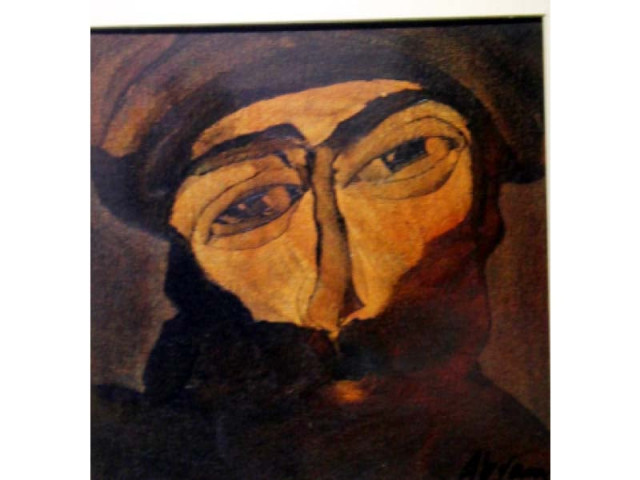
Baloch has many credentials to his name. He is the chairperson of the University of Balochistan’s department of fine arts and a recipient of the President's Pride of Performance Award, 2004. His expertise lies in telling untold, indescribable stories of people who have suffered due to the poor socio-economic conditions of a country drowning in political turbulence, which is, unfortunately, Pakistan.
In his show, titled 'Shenakht', Baloch has dealt with powerful mask and statue-like faces with sharp, elongated noses and well-defined eyes. The backgrounds are dusky and rustic with hues of orange and brown that are not able to detach from the air of sullenness, even when the landscape is suggestive of streams and fresh fields.
Speaking to The Express Tribune, the artist delved into the time of General Ziaul Haq, when social oppression was at its peak and artists looked for ways to express themselves and that aspect of society. Unfortunately, the contemporary scene is no different, as oppression has taken new forms in terms of enforced disappearances and people are still pondering over the dilemma of identities. "It was a difficult time in those days. It is still that way today too," he said.
The mask-like faces, although different in terms of masculine and feminine features, tend to have underlying similarities. The men and women are both hidden behind their own layers. Men with their head turbaned and mouths covered in beards and women hiding behind their veils, covering their lips; there is a strange resemblance in their masks. This seems more pronounced as their eyes are broadly lined and blank. The blankness has its own distressing edge to it, reaffirming the belief that eyes speak a language of their own, only understood by those who seek to delve into the depths not apparent to everyone.
It is the projection of women that is disturbing, to say the least, yet one cannot help but admire the intricate, glossy texture it has been depicted with. "It is the women who are ultimately left behind in tragedies. The work is luminous, so it's more impactful," said writer Rumana Husain.
Another interesting part of the exhibition is the chest-like boxes that have a similar sort of carvings as the artwork. "These are actually boxes that were in use by the British in colonial times," explained Baloch. He used the technique of relief carving to show contemporary suffering and oppression. While one box is laid open, others are bolted shut. "These are the screams of society," he said.
The exhibition will run till October 14. The Chawkandi Art Gallery is open every day from 11am to 8pm.
Published in The Express Tribune, October 9th, 2015.


















COMMENTS
Comments are moderated and generally will be posted if they are on-topic and not abusive.
For more information, please see our Comments FAQ